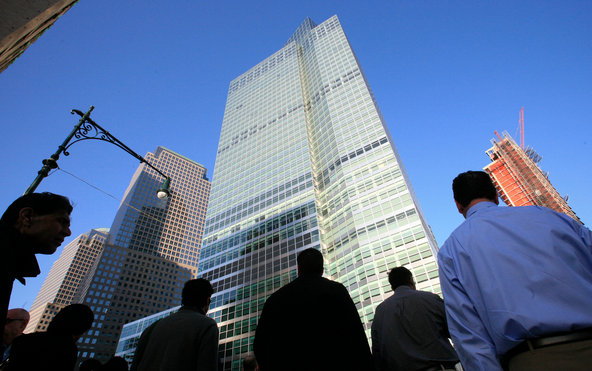 Mark Lennihan/Associated PressThe headquarters of Goldman Sachs in New York.
Mark Lennihan/Associated PressThe headquarters of Goldman Sachs in New York.
9:46 a.m. | Updated
Goldman Sachs on Wednesday reported a fourth-quarter profit of $2.89 billion, or $5.60 a share, a significant jump from the period a year earlier.
The per-share figure is after the company paid preferred dividends, and comes in well ahead of analysts’ expectations of $3.78 a share, according to Thomson Reuters.
Related Links
Analysts had been anticipating a fairly decent quarter for Goldman, and its results were buoyed by strong trading and investment banking results and lower compensation costs. In the fourth quarter of 2011, the bank earned $1.01 billion, or $1.84 a share.
The bank’s most recent results reflect a continued focus on cutting expenses as well as a number of investing gains, including $485 million from debt and security loans, the company said.
“While economic conditions remained challenging for much of last year, the strengths of our business model and client franchise, coupled with our focus on disciplined management, delivered solid performance for our shareholders,” Goldman’s chairman and chief executive, Lloyd C. Blankfein, said in a news release.
The results had an immediate effect on the firm’s stock, sending it up 2.7 percent in early morning trading.
Over all, the firm produced $9.24 billion in revenue in the quarter ended Dec. 31, up 53 percent from the same quarter in 2011. That also beat analysts’ estimates of quarterly revenue of $7.91 billion.
Goldman also revealed how much it had set aside for compensation, paying out $12.9 billion in 2012, an average of $399,506 to each of its 32,400 employees. This represented 37.9 percent of Goldman’s revenue for the year.
Over the last year, Goldman has reduced its payroll by 900 people. In 2011, the bank set aside $12.22 billion, or 42.4 percent, of its 2011 net revenue to pay compensation and benefits for its employees.
Goldman partners, a small group of top managers at the firm, will learn their 2012 compensation packages on Wednesday. The vast majority of employees, however, will be told what their bonuses will be on Thursday in what is known at Goldman as compensation communication day. These bonuses are on top of annual salaries, which can range from roughly $100,000 to $2 million for executives like Mr. Blankfein.
Bonuses on Wall Street — both the size of them and how they are paid — always draw scrutiny. Goldman Sachs decided this week not to delay the payment of bonuses to its staff members in Britain, a move that would have helped investment bankers and other highly paid employees benefit from a lower income tax rate.
Goldman Sachs was already drawing attention in the United States after it distributed $65 million in stock to 10 senior executives in December instead of January, when the firm typically makes such awards. That move helped the executives avoid the higher tax rates that will now be imposed on income of $450,000 or more.
The firm’s annual return on equity was 10.7 percent, up from 2011, when it was 5.8 percent. While this is far below its performance in boom years like 2006, when its return on equity was 41.5 percent, it is an achievement that it has broken above 10 percent.
Banks continue to fight difficult economic conditions at home and abroad, and Goldman’s results are still well below what it was producing before the financial crisis. Those outsize profits, however, were fueled by borrowing on credit and selling mortgage-linked products, and they have dwindled. New regulations aimed at reining in risk-taking have also reduced the profitability of certain businesses.
Revenue from investment banking came in at $1.41 billion, up 64 percent from the year-ago period.
Net revenue in Goldman’s powerful division that trades bonds, currencies and commodities was $2.04 billion, up 50 percent from levels in the quarter a year earlier. The firm said those results reflected an increase in mortgage revenues, which were “significantly higher” when compared with 2011.
The firm’s investing and lending division also had a stronger-than-expected quarter, posting revenue of $1.97 billion, up 126 percent from year-ago levels. The firm said this unit benefited from an increase in equity prices in Asia and Europe and a number of one-time gains. For instance, it logged a gain of $334 million from its investment in the Industrial and Commercial Bank of China, a strategic investment the firm made in 2006. It also had gains from the debt securities and loans it holds.
Goldman is one of a number of banks releasing earnings this week. JPMorgan Chase also Wednesday weighed in with its results, reporting a strong profit of $5.7 billion for the fourth quarter, up 53 percent from the previous year.
These positive results put pressure on Morgan Stanley to post good results when it releases its fourth quarter numbers on Friday. Analysts polled by Thomson Reuters are expecting Morgan Stanley to report earnings of 27 cents a share, up from a loss of 14 cents in the year-ago period.
Article source: http://dealbook.nytimes.com/2013/01/16/goldman-profit-soars-to-2-89-billion-in-4th-quarter/?partner=rss&emc=rss